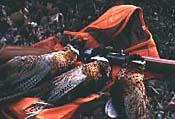|
|
 |
 |
Pheasant Hunting Tips When many hunters think of upland game, the Chinese Ringneck Pheasant often holds the number one position. This gaudy cackling bird can hide in the smallest amount of cover, run through the thickest brambles, and then burst from cover to take wing.
Early in the season, pheasants sit tighter, allowing the hunter and dogs to approach them in their resting areas. Since the birds haven't been pressured much at this point, shots are usually at close ranges, and a twelve gauge shotgun with modified or improved chokes and #6 shot make an excellent early season load. This is also the time of year to unlimber your 20 or 28 gauge gun for these early birds. As the season progresses a tighter choked gun is a better choice. For best results, switch to a 12 gauge gun, shells with more powder and #4 or #5 shot. The birds will be flushing wild in many cases, and the heavier loads provide a bit more knock down power at longer ranges. Pheasants prefer thick cover for resting, that's why CRP lands (set asides) have increased the pheasant population throughout the Midwest pheasant belt. The larger tracks of thick grass allow pheasants to escape the sharp eyes of predators. In years before CRP, pheasants rested and nested whereever they could find cover. In many areas this was along fence lines. Predators (raccoons, skunks, coyotes, and fox) had easy pickings, since all they had to do was follow the narrow fence rows to find their prey. Many CRP fields in the upper Midwest are several hundred acres, and the tall cover gives pheasants the opportunity to escape predators. Since heavy grass and cover is where you'll find most birds, a good dog comes in handy. A dog will find birds that hold tight. Many times you'll walk right past a hiding rooster, only to have him burst from cover once you've walked past. Once you've knocked a bird down, a good dog is invaluable. Wounded birds can run fast, and fewer birds are lost by hunters who use dogs. The breed of dog isn't important, as long as the dog works close and listens. Nothing is more frustrating than hunting with a dog that runs too far ahead, flushing birds out of range. Successful hunters find that they will flush more birds by walking slowly and quietly, working back and forth across the field. This forces the bird to either flush or move ahead of the walkers, giving blockers at the end of the cover an opportunity for a shot. When hunting large cover or corn fields, you'll need a "blockers". Pheasants are known for their running ability. They'll run away from hunters. Blockers are hunters stationed at the end of the field who get shots as birds break from cover. The presence of blockers forces birds to hold tighter, giving both walkers and blockers more shooting action. Safety is a very important consideration when hunting pheasants. Pheasants will bust out of cover behind, between and right under a hunter's feet. Each hunter should know where it is safe for him to shoot. When using blockers, it's very important to remember exactly where the blockers are. As hunters near the end of the field, they'll need to know who is going to do the shooting. In most cases the blockers control the end of the field, and walkers shoot at birds that might have been walked by and get up behind them. Hunter orange should be worn by all hunters, because if you can't be seen, it's tough to shoot safely. Orange vests, caps (especially caps), dog collars, and dog vests all help to make a safer hunt. Make sure you only shoot at high rising birds that are in a safe line of fire.
|
|
|
| Site design by Outdoor Management Network Inc. Copyright © 1996 - 2007 Outdoor Management Network Inc. America Outdoors® is a registered trademark of Outdoor Management Network Inc. |
 Hunting pheasants is a challenge, but tips from long time pheasant hunters can help you outwit the wily pheasant.
Hunting pheasants is a challenge, but tips from long time pheasant hunters can help you outwit the wily pheasant.